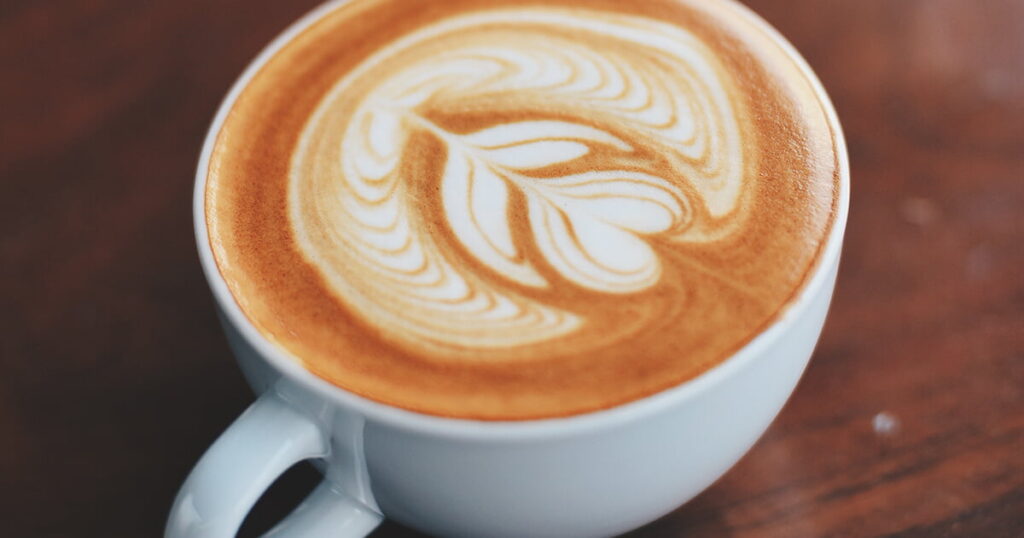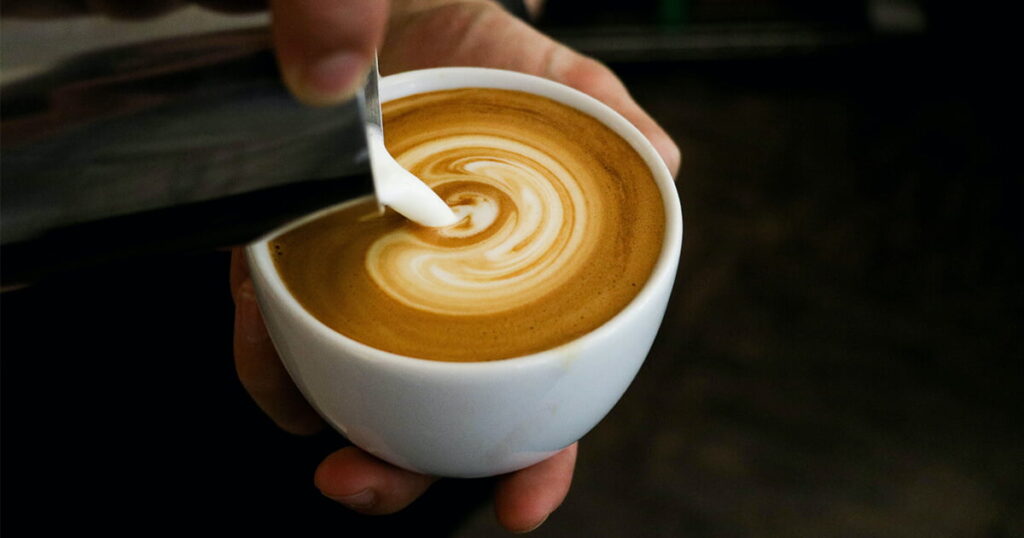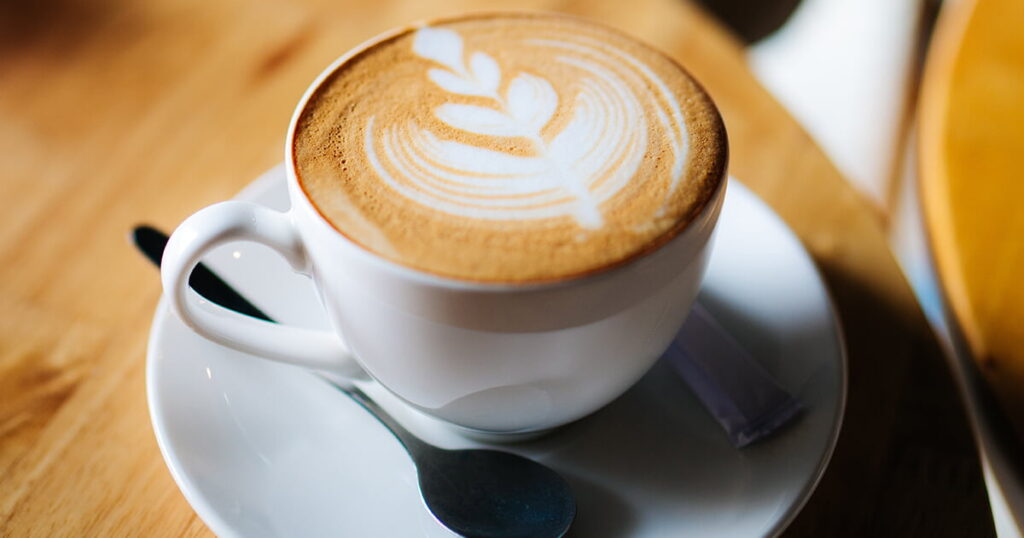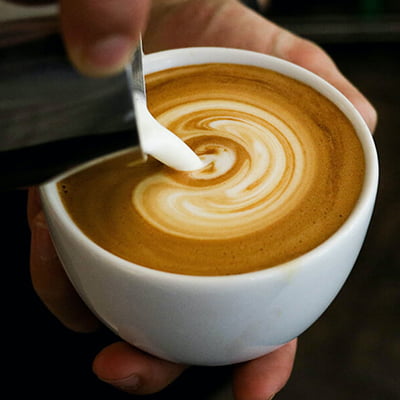With the multiple coffee beverages we encounter in our lifetime, one drink always makes it to the menus of the cafes we visit–the cappuccino. Despite how fancy the name sounds, the cappuccino is really simple and remains a constant favorite amongst coffee lovers worldwide.
In this article, we are going to discuss all there is to know about the cappuccino–from its history and components down to every minute detail, like caffeine and calorie content. And at the end of it all, even a step-by-step recipe on how to make your own version at home!
| Cappuccino | |
|---|---|
| Main Ingredients: | Espresso, Steamed Milk, Foam |
| Serving Temperature: | 55–65°C (139–149°F) |
| Place of Origin: | Vienna, Italy | Caffeine per Serving (mg): | 12.83 mg of caffeine per fl oz 40-64 mg of caffeine for a regular 5 to 5.5-ounce cup with 1 shot of espresso.
Note: Light-roasted espresso will have more caffeine content than dark ones. |
What Is Cappuccino?
The cappuccino is probably the most popular coffee drink ever invented. It is known for the perfect balance of espresso and milk and is characterized by the airy froth on top. This beverage should taste rich and mildly sweet because of the milk and a stronger espresso flavor than most coffee blends.
What Is the Cappuccino Made Of?
In a perfect world, a cappuccino is simply espresso and milk. The drink is usually compared to a latte or cortado, which is composed of the same ingredients. However, the cappuccino becomes more distinct and a little complicated to make because of the inclusion of microform.
Several coffeehouses in the American market serve cappuccinos with thicker foam as compared to the milk beneath it. This is quite different from how Italian coffee lovers tend to prepare this beverage which is composed of coffee, steamed milk, and microfoam in equal proportions.
More complex innovations from modern coffee chains introduced us to different kinds of cappuccinos. Some local cafes prepare the supposedly simple beverage with a dash of chocolate or cinnamon powder.
Meanwhile, some coffee shops even go to more extreme routes and offer cappuccinos in iced and blended formats–replacing the layer of froth with whipped cream or cold milk foam.
The History Of Cappuccino

Image credit > Chevanon Photography from Pexels
The traditional coffee preparation was actually very simple hundreds of years back. There was no coffee equipment or espresso makers then, so beans were simply boiled in water. But during the 1700s, Italian coffee houses finally heard the term “cappuccino” for the first time.
Kapuziner–this was what the first cappuccinos were called in the early Viennese cafes. This drink is made of coffee, cream, and sugar and is brown in color, which is similar to that of the robes of Capuchin or Kapuzin friars in Italy.
During the 1930s in Northern Italy, cappuccinos were made with coffee and whipped cream in the traditional Viennese style. This is probably the inspiration for today’s espresso con Panna. When the first espresso machine with a steam wand started becoming more popular in the 1950s, the usual whipped cream was replaced with foamy steamed milk–and this is how the modern-day cappuccino was born.
Just as Italian coffeehouses began penetrating the American market in the 1980s, cappuccinos also started to become more and more popular. With the more widely available espresso makers and the celebration of coffee crema, the perfect modern cappuccino–rich espresso, luscious crema, and frothed milk–continues to entice many coffee aficionados around the globe.
How Much Caffeine Is In Cappuccino?
Just like its brothers, latte and macchiato, the cappuccino is made with one or two shots of espresso per serving. The caffeine content on your cappuccino mainly depends on the amount of espresso added to your drink. In general, a normal cappuccino is 5 to 5.5 ounces and usually has about 173 mg of caffeine (1 shot of espresso) per serving.
How Many Calories Are In Cappuccino?
Whenever we order our favorite cup of coffee in a cafe, we sometimes get conscious of the number of calories we are about to intake. And as much as we love to sip into our cappuccinos and get our lips a little messy with froth, we may also recognize that this beverage will tend to have more calories than the plain black coffees on the menu.
Lattes, for the most part, contain high amounts of fat, protein, and calories. This is mainly because it’s composed of varying amounts of milk and sometimes even sweeteners. This only means that cappuccino will tend to have fewer calories than a cup of latte since it contains a bit less milk too.
Generally, a 5 to 5.5-ounce cup of cappuccino contains about 60 calories. However, this also depends on the type of milk we use when blending. For example, 2% and low-fat milk will give you fewer calories than ordering one with full-cream milk.
How To Make A Cappuccino?
The next time you visit a local coffee shop, order a cappuccino and observe how the barista handcrafts your beverage. Now it may look like an easy task to do but perfecting a cappuccino requires a very detailed set of skills. We’re not just talking about heating milk but rather, proper aeration to achieve the desired microfoam. We’re not just talking about brewing coffee but rather manipulating the machine to create perfect espresso with a rich crema.
In this step-by-step guide, we will teach you how to make a great cappuccino–from the frothing of milk down to cappuccino art.
The Best Milk For A Cappuccino
How do you choose which milk is best to use in making a cappuccino? Below are notes you should remember:
Use cold fresh milk always. When you try to steam milk that’s already nearing its best-before date, you will not achieve your desired milk foam. Also, ensure that it’s refrigerated before usage so you’ll have more time for steaming and creating silkier foam.
The best type of milk is whole milk because it has the highest fat content, which is important in frothing. You can also use 2% milk, but it is not as rich. It’s difficult to thicken the texture of low-fat dairy and will only get you the least amount of milk foam.
For vegan cappuccinos, oat milk is the best non-dairy option for frothing. Almond milk and soy milk produce much less foam.
Steaming And Frothing Of Milk

Image credit > Taylor Franz from Unsplash
Proper milk frothing is significant in creating a perfect cappuccino. Baristas take high pride in being able to produce microfoam for espresso beverages as it takes lots of time and practice to perfect. We are here to share some tips you may need to know when steaming and frothing your milk.
Tools You’ll Need:
- Stainless Steel Steaming Pitcher
- A Calibrated Thermometer
- Fresh Cold Milk
- Espresso machine
- Shotglasses
- Serving Cup
Brew the shots.
Dose the portafilter with your desired amount of ground coffee beans. Tamp and lock this into one of the group heads in the espresso maker or machine, put the shot glasses in place, and start brewing. Wait for a few seconds until the extraction comes to a complete stop.
Pour the milk into the pitcher.
Fill cold milk into your steaming pitcher until it reaches just below the pour spout. Place the thermometer accordingly and ensure the tip is fully submerged in the milk.
Purge the wand and turn on the steam function.
When the espresso machine is fully turned on, wait for a couple of minutes for it to heat up to its ideal boiler temperature fully. Ensuring that you use the right kind of steam (dry steam instead of wet steam) is essential to produce microfoam. Ready the steaming wand by purging it to remove any residual water–turn the wand’s steam mode, wait for about 5 seconds, and turn the valve open until the water becomes steam.
Aerate the milk.
Submerge the tip of the steam wand and position it just slightly below the surface. Turn on the steam wand at full blast and start frothing your milk. Ensure the tip of the wand is horizontally placed just below the surface of the milk until you hear a paper-tearing sound. After about 8 seconds, reposition the wand pointed straight down, submerging about half of its body into the milk. This will ensure that the air bubbles will be incorporated into the steamed milk until you achieve your desired microfoam.
Stretch the milk.
As you continue steaming the milk, its volume also increases–this is called “stretching”. Keep the vortex swirling your milk until the temperature reaches around 100°F to 115°F. If you do not have a thermometer, feel the sides of your steaming pitcher until you feel it’s already warm enough.
Finish steaming.
Once you achieve the desired milk temperature, close the machine’s steam valve fully and utilize a damp cloth to wipe the steam wand clean. Purge the steam wand for the last time. Sanitizing the steam wand this way will prevent milk foam residue from getting stuck in it, which may solidify in the long run and affect the quality of your steamed milk. Finally, check out some bubbles forming in your milk. If you ever find any, tap the bottom of the pitcher onto the counter to pop the bubbles–you will see a smoother milk texture thereafter.
Serve your cappuccino.
Pour the desired amount of espresso shots into your serving cup. Swirl the steamed milk once more in order to incorporate the foam into the milk. Free-pour the steamed milk until the cup is nearly full. You can serve the drink as is or top it with chocolate or cinnamon powder to add some flavor.
Cappuccino Art (Latte Art)

Image credit > Harris Vo from Unsplash
Cappuccino Art or Latte Art is a small pattern or sculpture made by mixing and spreading the microfoam of steamed milk to the crema of the espresso. Baristas undergo thorough training and practice to produce this artwork–they would usually regard the milk as their pencil and the espresso as the canvas.
There are two main types of latte/cappuccino art–free pouring and etching. Etching primarily involves the usage of a sharp instrument, such as a toothpick or an etching pen, to draw an image into the finished latte. Sometimes, these designs can be more intricate, varying from simple etched line patterns to 3D animal characters. On the other hand, free-pouring skips the need for using a tool to draw on the espresso drink. However, this is more difficult to achieve since it comprises a more rounded skill in creating a perfectly textured foam and controlling the pour of your milk. Classic examples of free-poured latte/cappuccino art include hearts, tulips, and rosettes.
How to do cappuccino art?
- Prepare your tools and ingredients–steamed milk, espresso shot, serving vessel, steaming pitcher, and etching instrument (as needed).
- Brew and slowly pour your espresso into the vessel allowing it to slide through the walls of the cup or mug.
- Steam your milk accordingly to create the perfect foam consistency.
- Once finished, tap your pitcher on the counter to remove excess bubbles and swirl the milk to incorporate the milk foam evenly.
- Tilt your vessel at a 45-degree angle facing towards the steaming pitcher.
- Begin pouring your thick pencil-width milk into the cup about four to five inches from the surface of your espresso.
- Once the cup starts to coffee mixture starts to form a white base, slowly level your cup upright.
- Wiggle your milk pitcher simultaneously, depending on the art you want to achieve. Below are a few examples.
- Cut the stream and finish the art.
- Heart: Slightly wiggle your pitcher backward until you see the white froth forming a round base on the brown espresso. When large enough, cut the stream by going forth the other side of the cup to form a heart.
- Rosette: Slowly wiggle the pitcher side to side until you see a fern-like figure on the espresso. Cut it in the middle to create a rosette.
- Tulip: Pour the milk foam until you see the white froth forming a round base on the espresso. Cut it instantly and pour again until you see another round base inside the first one you made. Do this several times until the cup is nearly full. Do the last pour and cut it right in the middle to create a tulip.

Equipment
- Steaming pitcher
- Frother/ Espresso machine with steam wand
- Serving cup
Ingredients
- 1 ounces of steamed milk
- 1 shot of espresso
- 1-2 ounces of microfoam
Instructions
- Prepare your ground coffee and begin brewing a shot of espresso.
- While the espresso is brewing, heat and froth the milk using a frother or the steam wand of an espresso machine. Make sure to froth the milk until it is hot and has a creamy, foamy consistency.
- Pour the brewed espresso into a 6-8 ounce cup.
- Slowly pour the milk over the espresso, using a spoon to hold back the foam.
- Top the cappuccino with a layer of microfoam.
- Serve the cappuccino immediately and enjoy!
Different Types Of Cappuccino
Hot or iced, wet or dry–no matter which variation you choose, there is a cappuccino out there to satisfy all coffee lovers. Below are several delicious variations of the classic cappuccino.
☕ Traditional cappuccino
The classic blend of espresso, frothed milk, and a thick foam topping–just as how many coffee shops in the world make it.
☕ Wet cappuccino
This is a richer, smoother take on the traditional cappuccino, with more milk and less foam. It would have a milder coffee flavor but would be milkier and denser on the palate.
☕ Dry cappuccino
This version features less milk and more foam, resulting in a stronger espresso flavor and a more pronounced foam layer.
☕ Flavored cappuccino
Just the traditional cappuccino with a touch of sweetness from the addition of flavored syrups. Vanilla, caramel or chocolate are the most popular choices.
☕ Iced cappuccino
A cappuccino served over ice. This is made with espresso, milk, ice, and cold milk foam on top.
☕ Blended cappuccino
A smooth, smoothie-like consistency created by blending espresso, milk, and ice and possibly topping it with whipped cream.
☕ Cappuccino Fredo
A type of iced cappuccino made with espresso and thick cold milk foam. This is loved because of its refreshing, smooth consistency.
☕ Cappuccino Italiano
This is a term that is often used to refer to the traditional cappuccino made in the Italian way. This is made with equal parts espresso, steamed milk, and microfoam and served in a small, 6-8 ounce cup. People order this to distinguish the Italian-style cappuccino from the larger, more milk-heavy cappuccinos that are common in the United States.
Frequently Asked Questions
How much milk to add to the cappuccino?
This depends on whether you want a bold espresso flavor or a milky taste for your beverage. Ideally, a cappuccino is composed of 25 ml of coffee and 85 ml of milk.
When to drink the cappuccino?
Traditionally, cappuccinos are consumed in the morning just like other coffee beverages. Today, one can drink a cappuccino anytime, especially with cafes everywhere.
Can I drink a cappuccino when pregnant?
The recommended daily caffeine consumption for pregnant women is less than 200mg. This means you can drink one 16-ounce cappuccino (about 173 mg of caffeine) per day when pregnant.
Where to buy cappuccino cups?
Cappuccino cups usually have wider rims and narrower bases than usual coffee mugs. You can buy them at almost every shopping store in the world–or you can order some online!
How much does cappuccino cost?
Every coffee shop has a different pricing standard when it comes to its beverages. On average, one order of a regular-sized cappuccino is about $4.36.
Where to buy a cappuccino machine?
You can buy cappuccino machines or cappuccino makers from home shopping centers or appliance stores. You can also try searching at online shopping sites like Amazon and eBay.
Is cappuccino made with coffee?
One main component of a cappuccino is espresso–a concentrated type of dark-roasted coffee offered in most coffeehouses around the world.
Which cappuccino maker brand to buy?
Famous espresso and cappuccino maker brands are Mr. Coffee, Breville, DeLonghi Magnifica, etc. Try to check out their respective features to find the best one for you.
Is it bad to drink a cappuccino every day?
Drinking a cappuccino or any other caffeinated beverage every day is okay as long as you consume them moderately. Up to 4 cups of coffee or about 400mg of caffeine is deemed safe for most people.
Does cappuccino go bad?
Just like any other drink, espresso and coffee will taste bad when they are not served fresh. A cappuccino goes bad pretty quickly especially if the temperature drops when it’s supposed to be consumed hot or warm.
When should cappuccino be drunk?
Traditionally, a cappuccino is considered a morning beverage. It is made with a shot of espresso and steamed milk that has been frothed to create a creamy texture. Many people find that the lactose and fat content of milk in a cappuccino can provide an energy boost to start their day off right. However, cappuccinos can be enjoyed at any time of the day, not just in the morning.
When is cappuccino day?
In the United States, National Cappuccino Day is celebrated every November 8th. During this holiday, many local coffee shops offer the best version of the beverage.
Is cappuccino healthier than coffee?
Cappuccino can be considered healthier than brewed coffee, as milk is a good source of protein and other minerals. However, this depends on how the drink is prepared and what ingredients are used. Cappuccinos made with whole milk and flavored syrups will be higher in calories and sugar.
Is cappuccino stronger than coffee?
The cappuccino has a stronger flavor than most regular milk-based coffees, such as the latte, since it’s made of less milk (more foam). However, they have the same strength, since they are made from the same amount of espresso However, beverages like the Americano is typically stronger since it’s just water and espresso. This also depends on how many espresso shots you add to your beverage.
Is cappuccino really coffee?
Espresso is a concentrated type of dark-roasted coffee and is one of the main components of a cappuccino, together with milk and foam. This makes cappuccino a legitimate coffee drink.
Summary
A cappuccino is a coffee drink made with espresso and milk finished with a layer of frothy foam on top. These beverages are made with one or two shots of espresso and can be flavored with chocolate or cinnamon. The drink has a rich, slightly sweet flavor and is traditionally made with equal proportions of coffee, steamed milk, and microform.
Cappuccinos can be served iced or blended with whipped cream or cold foam as well. The modern cappuccino was born in the 1950s when espresso makers or machines with steam wands became more popular in coffeehouses across Italy.
Generally, a 5 to 5.5-ounce cappuccino typically contains 173 mg of caffeine and 60 calories, but this can vary depending on the amount of espresso and the type of milk used. To make a cappuccino, a barista will start by pulling a shot of espresso and then steaming and frothing the milk. The frothed milk is then poured over the espresso and topped with a layer of foam.
Main image credit > Karolina Grabowska from Pexels

